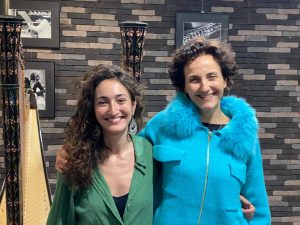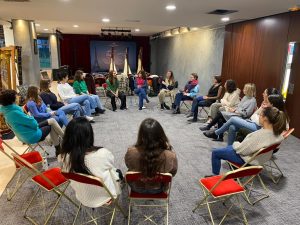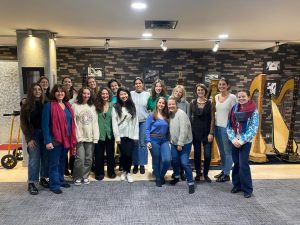Camac Blog
“Master and Radiate your Art”: interview with Hélène Tysman
Latest
January 27, 2023
Few people would describe the life of a musician as a smooth ride, and many of the world’s most famous musicians suffer from crippling stage fright like everyone else. It’s comforting enough to know that you’re not alone – and that strong emotions can be powerful if you master them.
We recently hosted pianist and artist coach Hélène Tysman for a day-long workshop in our Paris showroom. The session was entitled “Master and radiate your art”, because for Hélène, it is the externalization of what lies inside that is a musician’s main task and challenge. Your Camac reporter, always curious, spoke with Hélène to find out more.
Connecting internal and external
“For me, the real challenge is the relationship with the external,” explains Hélène. “When an artist comes on stage, he or she has to express himself or herself, that is to say, externalize the internal. This is perhaps a human being’s most subtle and demanding challenge. You have to ask yourself: ‘what do I have to bring to the world that is unique, singular and precious?’ Perhaps you have been hurt somehow, and after a while you no longer dare express yourself. But the courage and strength to express yourself, and bring out an inner world, is the artist’s very task. Artists are often very sensitive people, because they are endowed – paradoxically – with this great power. For me, sensitivity is a channel. But if the channel is not well used, you might feel like you’re hitting a wall.”
The more sensitive you are, the more you need to control your emotions – but not suppress them. “It’s like driving a Formula 1 car,” Hélène continues. “If you’re not used to it or think you’re driving an ordinary two-wheeler, you might crash. But it’s not that you’re driving badly, it’s that you have a Formula 1 car in your hands. When you’re facing each other, I would say that the biggest challenge for an artist is: ‘Am I grounded? And at the same time, am I fully connected to what is most important for me to convey?’ Only then can I feel secure while communicating externally.”
Focus on inner authority
Hearing this, the first thing I want to know is how can artists have confidence in their own worth, and in their value to the world? Social media bombards artists with images of other people’s extraordinary lives, which doesn’t help your self-esteem. “That’s true, but I don’t think the ‘star system’ is the problem,” says Hélène. “There are plenty of opportunities to get distracted, and the effect of that is that it’s easy to believe that the power is external to yourself. Whether it’s your banker, a competition jury or a music critic…the real question is: “where is my own authority? It is essential to (re)discover my personal power and what it will allow me to transmit. It’s not just playing music or the harp…it goes much deeper than that.”
It is this reconnection to personal power that is at the heart of Helene’s definition of self-mastery. “In itself, ‘master’ is often misunderstood, like ‘manage’, ‘control’ or ‘be strong’, for example. Emotion is definitely not there to be managed! It is what precedes it that can be mastered: the thought and, beyond that, the mechanics of thought, its internal system. I use the word ‘master’ to refer to the inner master, and thus to become the master of your very first instrument: the self. It is astonishing to see how young virtuosos master their external instruments, without starting with their very first instrument – their selves.”
A question of mindset

Hélène with Isabelle Moretti, who has worked a lot with her and whose idea it was to hold the workshop in Paris.
From meditation to introspection, today’s neuroscience and spiritual sages agree about the power of the mind over its experience. It’s important to focus your attention on what you can change, not on what you can’t, and also to recognize the power of your state of mind. “This is about mindset”, says Hélène. “In concrete terms, mastering yourself means having a much more expanded consciousness. If I master my mind, I will be able to take a step back or distance myself from a place where I might feel overwhelmed. Conversely, I can also learn to be much more present, when my mind might otherwise wander.”
Flip the switch
If this were easy, we would all naturally switch from one state of mind to another depending on which one is more constructive for a given situation. In reality, it is something most of us need to learn, and there are structured techniques to help us do so. Hypnosis, one of Helene’s specialties discussed at the Paris workshop, is one. She explains: “Hypnosis is essentially about reprogramming. Unconsciously, we spend our time associating particular experiences with particular reactions. We are all a bit like Pavlov’s dog, most often without realizing. As a result of internal conditioning, we react to our first name. But there is nothing objectively real; you could be called something else. It is imagined and organized by our minds. If the emotional charge is de-anchored and dissociated, even a traumatic memory can be released. This is what I like to call wisdom. The learning remains, but there is no longer any tension because the emotion is no longer tied to that scene. The biggest discovery I had with hypnosis is the idea that everything is changeable, transformable! Everything is in motion. As a pianist myself, I was quite fatalistic. I thought that stage fright was inevitable and that competitions were difficult. I didn’t want to believe that I had, within me, just like anyone else, the capacity to change this and to live it differently.”
Getting into the mechanics
There are other reprogramming techniques in addition to hypnosis, such as NLP. How do they work? According to Hélène, the common point of all reprogramming techniques is that they work on the subconscious. “The language of the subconscious mind is a lot more fun than you might think, because it changes and can be changed. You can visualize the concept: what do you see, and what do you associate with it? And then, how do you live with that? The Spanish use the same word for ‘create’ and ‘believe’: ‘yo creo lo creo’. We create what we believe. Everything I believe, makes me live my world. The brain does not have the capacity to live in a world in which it does not believe.
It is therefore possible to transform our beliefs. For example, young children are sure Father Christmas exists. At some point, the reality changes. What has changed is not so much whether or not Santa Claus exists, but how you felt about either of these beliefs, since that is what you were making yourself experience as an absolute truth.
Thanks to hypnosis or NLP in particular, it is possible to enter into this mechanism. Sometimes simple awareness is enough to transform a state of being or a situation.”
But what about intuition?
Can we really think of stepping out of one reality into another? I like to think so, but I want to know more. I’m intrigued that Hélène is also working on intuition with musicians: it seems to be something different. How do heart and mind go together?
“There are three types of intelligence,” explains Hélène. “The body, the heart and the mind. Musicians can understand this easily: in music, you need three notes to make a perfect chord. And each of those three notes has to be in tune, with itself and with the other two. As a musician, it is natural for you to tune your instrument daily. It is the same with your self. Sometimes the instrument gets out of tune and you readjust it; you do this all the time. This is when you can access a potential that goes far beyond the brain. The heart has an immense intelligence. It has been scientifically proven that the reactions of the heart precede an actual situation by about a second. There is also the intelligence of the body: the instinct, which is a huge channel. If emotional intelligence is only beginning to blossom, it is because modern society may have tended to keep us away from it. Fear comes from the idea that emotion will make us go crazy, or make us do anything… But when everything is in tune, when we are in harmony with our thoughts, our emotions and our body, then our actions are right and a fluidity is established throughout our evolution. And when there is this fluidity, there is more space to relax. Relaxation is particularly conducive to the presence of intuition: when everything is in balance, you are more powerful and motivated.
The opposite of intuition would be conditioning, i.e. learning from something external, most often unconsciously. How can we tell the difference? We know if a thought or an attitude is a conditioning if it either limits us or, on the contrary, opens us up.
Descartes’ “I think, therefore I am” has probably been misunderstood. In reality, it is a matter of learning to observe, and therefore to put thought at a distance. I often ask two essential questions when a thought occurs. The first is: ‘Does it do me good?’ And the second is: ‘Is it useful to me (and for what?)’. During the session, I often invite the person to question the story they are telling themselves… Because we are storytellers! My deepest wish is to allow artists to realize that they are not the plaything of their imagination. On the contrary, they can play with it.”
You can discover Hélène’s work on her websites: www.helenetysman.com and www.hypnosedumusicien.com. Don’t forget to check out her own blog and other writings, which elaborate on these and other topics, deeply focused on the artist’s point of view.



